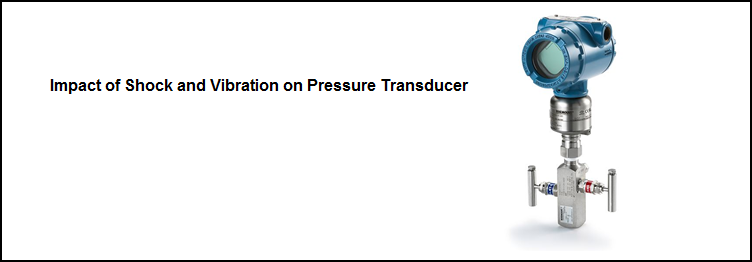Blog
Impact of Shock and Vibration on Pressure Transducer
Impact of Shock and Vibration on Pressure Transducer
July 09, 2019
A pressure transducer is a device that measures the pressure of gases or liquids. They are used in applications requiring high-resolution and accurate measurement of pressure. They are highly sensitive, and a few factors need to be considered during and before their installation to get the desired results. Vibration and shock are commonly overlooked factors. They are the worst enemies of pressure transducers and are not easily identifiable. Would you like to know how shock and vibration impact the performance of a pressure transducer? How to prevent pressure transducer problems? Read the post to know more.

Introduction to Mechanical Shock and Vibration
Shock and vibration are not the same and can destroy a pressure sensor if it’s not built to withstand the situation.
- Shock: Shock is defined as a momentary impact. It is an impulse that transfers energy to the system within less period of time. Shock can occur from rough handling and transportation, such as by conveyor system, forklifts, and industrial trucks. Single shock does not affect a transducer, but it can experience failure with many low-level shocks. It is considered as a way to initiate vibration within the system.
- Vibration: It is defined as a mechanical phenomenon of oscillations that occurs either periodically or randomly. For instance, in the case of an engine test, the running engine produces a constant vibration. As a result, it affects the performance of the pressure transducer if it is mounted too close.
What Problems Do Shock and Vibration Cause?
Pressure transducers are subjected to mechanical shocks and vibration in many applications such as compressors, mobile machinery and also during transportation on bumpy roads. There are various factors that can cause shock and vibration. Here are a few of them.
- Broken Circuit Boards
- Mechanical Hardening
- Unwanted Noise
- Connector Separation
- Broken Enclosures
- Damaged Signals
Effective Ways to Prevent Pressure Transducer Issues
Shock and vibration can hamper the performance of pressure transducers. A faulty pressure transducer will provide inaccurate measurements, and give rise to unnecessary costs. Here are a few pointers by which you can reduce the possibility of pressure transducer failures.
- Placement of the Transducer: As we know, shock and vibration cause problems for pressure transducers. These problems can be eliminated by placing the transducer as remotely as possible.
- Eliminate Electrical Disturbance: During the conversion process of pressure into an electrical signal, the pressure transducer can be naturally influenced by external electrical disturbance. This interference is caused by various sources including power lines, computers, cell phones, and so on. The impact of such electrical disturbance can be avoided using specific RF design constructions, including such as shielding, filtering, suppression.
- Control Overpressure: Overpressure can result in fault reading or permanent diaphragm damage. Understand the dynamics of your system and set the pressure limits accordingly. This will help prevent overpressure problems.
- Control Temperature: Many components of pressure transducers operate under a specific temperature range. This can lead to inaccurate performance. Controlling high derivation in temperature will help overcome this problem.
Most of the time, sensor failure occurs due to the use of the wrong transducer for a specific job. Thus, it is important to discuss the design construction of the pressure transducer with a leading transducer supplier. The Transmitter Shop is one such company that offers you accurately designed transducers that suit your needs. Over 30 years, the company offers high-quality pressure transmitters, while keeping industry standards in mind. Contact us today if you need a custom pressure sensing solution.

- Comparison between Multi Valve Manifolds Block Valves and Bleed Valves
- Understanding Electrochemical Detection: Principles, Techniques and Environmental Application
- How Can Greenhouse Gas Emissions Be Reduced?
- Pneumatic Pressure Controllers: A Safe Choice for Hazardous Areas
- A Practical Guide to Vacuum Measurement and Operation
- Understanding Electrochemical Detection: Principles, Techniques and Environmental Application
- How Can Greenhouse Gas Emissions Be Reduced?
- Pneumatic Pressure Controllers: A Safe Choice for Hazardous Areas
- A Practical Guide to Vacuum Measurement and Operation
- An Unconventional Guide to Selecting the Right Pressure Sensor
QUICK ENQUIRY